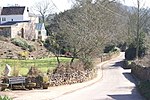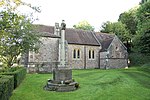Ebbor Gorge

Ebbor Gorge is a limestone gorge in Somerset, England, designated and notified in 1952 as a 63.5-hectare (157-acre) biological Site of Special Scientific Interest in the Mendip Hills. It was donated to the National Trust in 1967 and is now managed by Natural England as a national nature reserve. The gorge was cut mostly into the Clifton Down Limestone, part of the Lower Carboniferous Pembroke Group, by water. The site was occupied by humans in the Neolithic Era and their tools and flint arrow heads have been discovered, along with pottery from the Bronze Age. There are also fossils of small mammals from the Late Devensian. The nature reserve provides a habitat for a variety of flora and fauna, including flowers, butterflies and bats.
Excerpt from the Wikipedia article Ebbor Gorge (License: CC BY-SA 3.0, Authors, Images).Ebbor Gorge
Deerleap, Mendip St Cuthbert Out
Geographical coordinates (GPS) Address Nearby Places Show on map
Geographical coordinates (GPS)
| Latitude | Longitude |
|---|---|
| N 51.234 ° | E -2.682 ° |
Address
Deerleap
Deerleap
BA5 1AY Mendip, St Cuthbert Out
England, United Kingdom
Open on Google Maps








